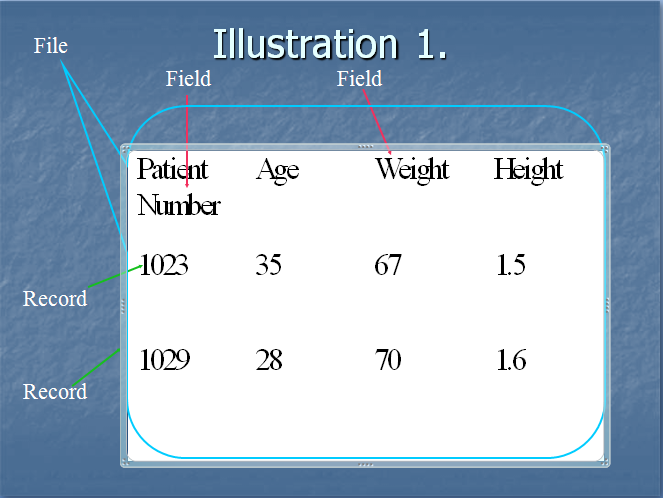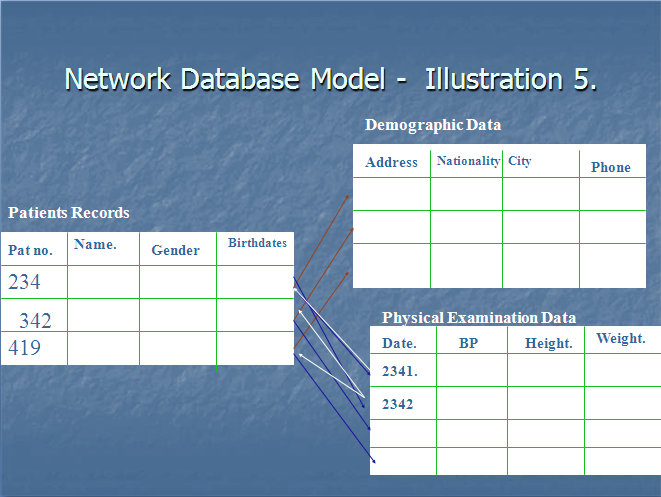In the present day information-based healthcare environment, it is vitally important that the information requirements of a healthcare organization are understood carefully and a health information system is developed. This paper explains the basics of a health information system developed for a small hospital.
Entities, attributes and relationships are the most fundamental concepts associated with the conceptual data model. An entity in this case is a patient. Attributes of the entity are name, gender, date of birth and medical record number. In a database environment field, record and file are the critical concepts. A character or a collection of characters make up a field and a record is made up of a collection of fields. Records represent a collection of records. All the three elements constitute a database (Chai & Chen).
The following picture presents a typical database.

A typical Health Information System consists of Clinical file for storing clinical data, pharmacy file having drug records, laboratory file for lab test records, administration file for keeping administrative records, financial file for keeping financial information relating to the patients and many other files depending on the information needs (Aduroja).
Data retrieval can be accomplished across the several fields by establishing relationships among the entities. This is made possible using key identifiers and foreign keys. Using the query method, the database management system would locate and access the relevant files, fields and records to find the information relating to the query (Databasics). There is no need for the user to know the name of the file, which contains the required information. It is possible to sort and quickly retrieve the information from a database by selecting one or more fields to act as keys.

The above picture illustrates a network database model in which all the patient related information are recorded for storing and immediate retrieval
For instance, from a database shown in the illustration, it is possible to use weight or age as a key to get information of all patients above certain age/weight. Index is a summary table, which enables the quick location of a particular record or group of records in a table. The database index works in a similar way as the index in a book works. For instance, the information on all patients having number from 1000 to 1999 can be retrieved.
One of the major limitations of the database system based on files is that there will be too many dependencies on application programs for changing a single file to a number of application programs. The other limitation is that there may be duplication of data occupying too much space. Sometimes there may be problems caused by incompatible files. Lack of the facilities for sharing data would lead to difficulties in accessing files especially to particular portions of the files. When there are separated and isolated data stored in a database, coordinating, assimilating and representing the data would become impossible which would defeat the purpose of the health information system (Prof.Holowcak).
Without standardization of data, it may not be possible to access the patient related information for drugs or treatment by different healthcare entities. For improving ease of analysis, it is essential that data be translated in to a single coding system. Hospitals can use diagnose codes and procedures from the standardized format (Sanderson, Adams, Budden, & Hoare, 2004). This would promote the linkage of records from different systems and enhance the clinical use of the patient related information.
References
Aduroja, O. (n.d.). Health Information System for Healthcare. Web.
Chai, S.-G., & Chen, Y.-F. (n.d.). Introducing Database. Web.
Databasics. (n.d.). Databasics I: Records and Queries and Keys, Oh my! Web.
Prof.Holowcak. (n.d.). Database Management Systems. Web.
Sanderson, H., Adams, T., Budden, M., & Hoare, C. (2004). Lessons from the central Hampshire electronic health record pilot project: evaluation of the electronic health record for supporting patient care and secondary analysis. BMJ Journal , 328, 875-878.